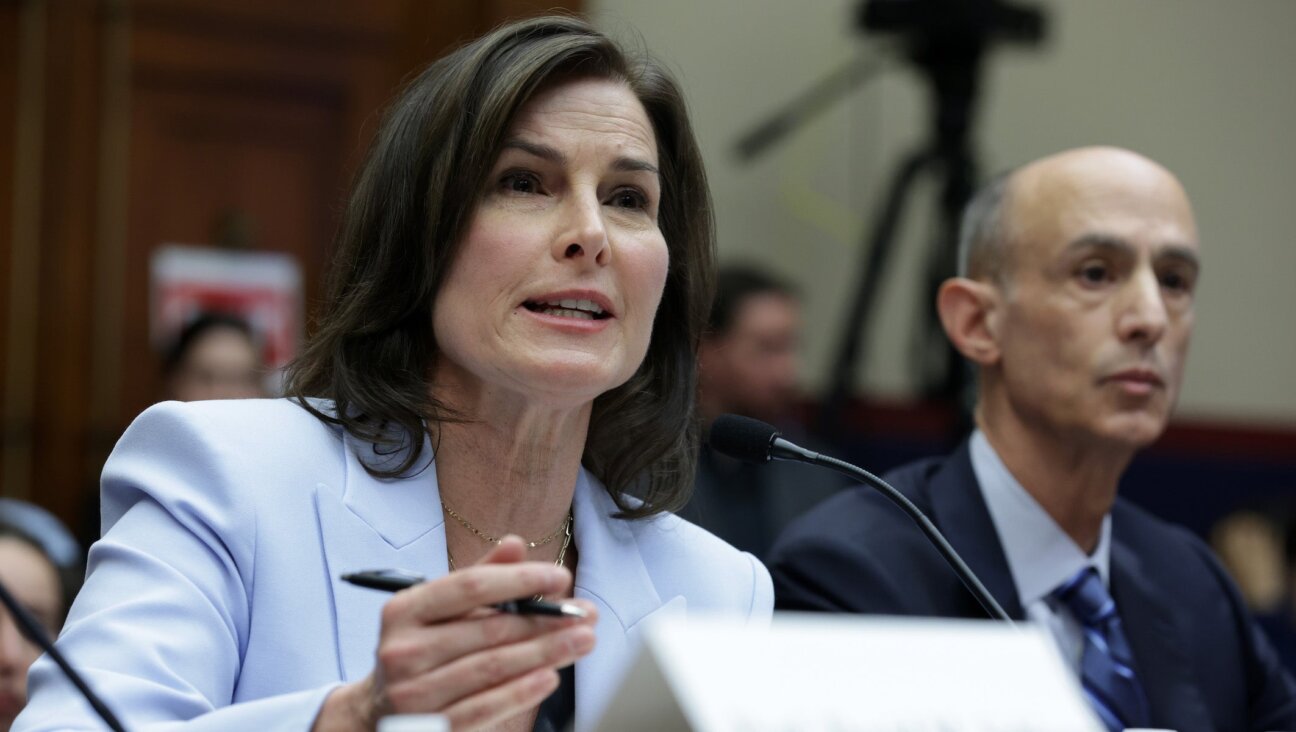New Opera Tells Story Of Robert Moses And Jane Jacobs — In The City Where They Battled

Graphic by Angelie Zaslavsky
“That could be cocaine, Lydia!” an older woman exclaimed as her friend knelt to retrieve a small plastic bag dropped by a passing stranger.
“A lot of Jews are lactose intolerant,” a nearby man observed.
The strangers stood close together on the ground floor of the glossy Lower Manhattan transit hub of Fulton Center. It was a Thursday in mid-June, and the ordinary rush of commuters in summer finery was diverting itself around an unusually large crowd.
They looked up at the central hall’s numerous screens. They jostled for spots on balconies and staircases
Then a stylized animation of turquoise waves lapping at the shore of a brick-red beach took over the screens, a small orchestral ensemble broke into a cascade of notes, and the singer Dashon Burton’s rich bass-baritone filled the hall.
It was the first performance of an excerpt from the new opera “A Marvelous Order” at this year’s River to River festival, a free arts extravaganza in southern Manhattan and Governor’s Island that runs through June 25.
The opera, with music by Judd Greenstein, animations and direction by Joshua Frankel, and a libretto by Tracy K. Smith, who was recently named U.S. Poet Laureate, tells a uniquely New York story: That of the mid-century battles over the planning of downtown Manhattan between Robert Moses and Jane Jacobs.

Image by C.M. Stieglitz/Library of Congress/Wikimedia Commons
Moses was the city’s so-called “master builder,” an urban planner who, following his seemingly miraculous creation of the enormous, pristine Jones Beach just outside New York City, was granted unparalleled control over the city’s development.
Jacobs, a journalist now considered one of the 20th century’s most influential thinkers on cities, was a public critic of contemporary theories of urban planning like those advocated by Moses, which prioritized orderliness over the quality of public life. (In a famed 1956 lecture at Harvard, she argued such tactics incurred a “social poverty.”)
The two first came into conflict in the late 1950s, when Jacobs helped head a movement opposing Moses’s plans to extend 5th Avenue through Washington Square Park.
That’s where “A Marvelous Order” begins.
But the scenes performed at Fulton Center, plucked from the opera’s second act, track Moses, played by Burton, from his first sight of the area that would become Jones Beach, through that project’s popular success, to the height of his power as he oversaw developments across New York City’s five boroughs.
“That building became less and less connected to the actual needs of people and became more and more ruthless,” said Greenstein, speaking to the Forward over the phone.
He was rueful when asked about the contemporary relevance of the story, which he and Frankel first began to craft into an opera in 2013.
“At one point as I was trying to describe the story I almost said ‘Donald Trump’ when I was talking about Robert Moses,” he admitted. “It’s not a stretch when you talk about people behaving without checks and balances.”
“There’s a resonance with the idea of this woman – who was notably a woman in a sea full of men in her field – changing the theory in her field completely, being regarded as the new standard-bearer, then also being a hugely important community organizer,” he added.
“We’re in a period where more and more people around the world are living in cities, over 50% of the world’s population lives in cities,” said Frankel. “Decisions are being made about what to build and where and why. Tied up in that [are] problems of displacement by gentrification.”
“These construction decisions, once something goes up, if it’s a bad idea it can take decades to come down.”
At Fulton Center, in the span of 25 minutes Moses transformed from a threat to the upper classes of Long Island – who feared that his plans for the enormous, public Jones Beach would disrupt their wealthy suburban enclaves – to a nascent menace of the disenfranchised, as he planned the housing projects that, as Greenstein said, would become “so derelict after their construction.”
Burton’s Moses, wearing a look of near-constant beneficence, appeared to be too caught up in the grandiosity of his own vision to understand its human impact. “And the immigrants?/The poor? Where/Will they go?” a young man, played by Tomas Cruz, asked him in the excerpt’s last scene.
“We’ll build them a monument/To modern opportunity,” Moses responded.
They stood on a high balcony, looking over the upturned faces of the audience below. As commuters filtered through, looks of awe breaking over their faces at the music soaring above them, the crowd that had formed in anticipation of the performance almost became a part of it. They smiled at the newcomers as if sharing a secret: Look at the surprises the city can hold.
Yet the site also highlighted some of the imbalances in the city’s ongoing planning. Fulton Center forms a transit link with the World Trade Center’s Santiago Calatrava-designed transit hub, opened last year at a taxpayer cost of $4 billion. It won’t be news to many that those billions might have come in handy to New Yorkers suffering, for instance, from the abysmal conditions in some of the projects left over from Moses’s tenure. $4 billion, in fact, would have made only a fractional impact for the New York City Housing Authority, which as of last December declared itself to have “$17 billion in unmet capital repair needs.”
That’s a point Jacobs, who later helped defend against Moses’s proposed Lower Manhattan Expressway (or LOMEX), might have made. LOMEX, which Moses justified as “slum clearance,” would have displaced nearly 2,000 families – likely into more of Moses’s housing projects.
As a character, Jacobs made no appearance in the River to River excerpt of “A Marvelous Order.” But ideologically, her presence was everywhere.
Famed for her awe-struck advocacy of the “intricate ballet” of city streets, it was easy to imagine her circling within the crowd just as the opera singers, dressed for the everyday, did. She might have passed a couple stopping to kiss by the subway turnstiles, or the older man gazing at Frankel’s animations with a look of joyous astonishment, and been pleased.
“That’s why we chose it as an opera,” Greenstein said. “It’s the rare case when you have theoretical concerns manifesting themselves physically.”
“It’s incredible that these two people who represented these opposite ideals wound up being physically in contest with each other in the battlefields of New York City.”






















